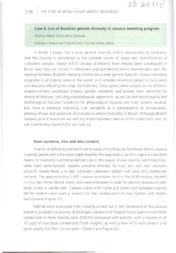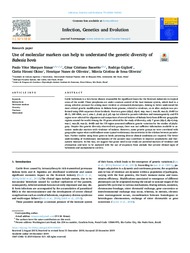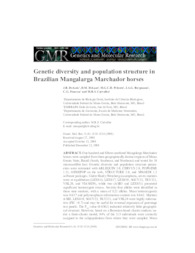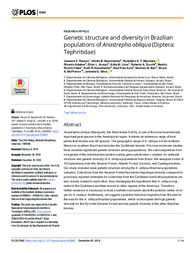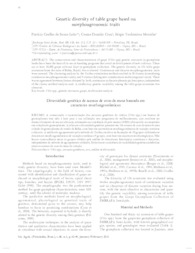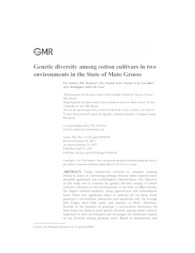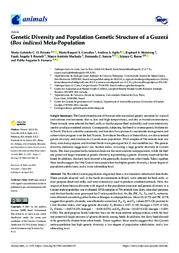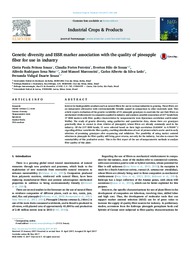Search Publications
Filter by:
| Author(s): FUKUDA, W. M. G. In Brazil, Cassava has a wide genetic diversity chiefly represented by landraces, and the country is considered as the possible center of origin and diversification of cultivated cassava. About 4,132... ... |
| Author(s): SIMAS, P. V. M; BASSETTO, C. C.; GIGLIOTI, R.; OKINO, C. H.; OLIVEIRA, H. N. de; OLIVEIRA, M. C. de S. Cattle babesiosis is a tick-borne disease responsible for significant losses for the livestock industries in tropical areas of the world. These piroplasms are under constant control of the host immune... ... |
| Author(s): ASSIS, J. B. de; LAAT, D. M. de; PEIXOTO, M. G. C. D.; BERGMANN, J. A. G.; FONSECA, C. G.; CARVALHO, M. R. S. One hundred and fifteen unrelated Mangalarga Marchador horses were sampled from three geographically distinct regions of Minas Gerais State, Brazil (South, Southeast, and Northeast) and tested for 10... ... |
| Author(s): PASSOS, J. F.; NASCIMENTO, D. B.; MENEZES, R. S. T.; ADAIME, R.; ARAÚJO, E. L.; LIMA, K. M.; ZUCCHI, R. A.; TELES, B. R.; NASCIMENTO, R. R.; ARCE, R. R.; BARR, N. B.; MCPHERON, B. A.; SILVA, J. G. Anastrepha obliqua (Macquart), the West Indian fruit fly, is one of the most economically important pest species in the Neotropical region. It infests an extensive range of host plants that include ov... ... |
| Author(s): LEAO, P. C. de S.; CRUZ, C. D.; MOTOIKE. S. Y. The genetic diversity in 136 table grape accessions from the state of Bahia, Brazil, was evaluated. |
| Author(s): COELHO, G. R. C.; BRONDANI, C.; HOFFMANN, L. V.; VALDISSER, P. A. M. R.; BORBA, T. C. O.; MENDONÇA, J. A.; RODRIGUES, L. A.; MENEZES, I. P. P. de The objective of this study was to analyze the diversity and discrimination of high-performance Brazilian rice cultivars using microsatellite markers. Twenty-nine rice cultivars belonging to EMBRAPA A... ... |
| Author(s): SANTOS, I. G.; TEODORO, P. E.; FARIAS, F. C.; FARIAS, F. J. C.; CARVALHO, L. P. de; RODRIGUES, J. I. S.; CRUZ, C. D. Using commercial cultivars to compose crossing blocks in cotton is a promising strategy, because these materials have desirable agronomic and technological characteristics. The objective of this study... ... |
| Author(s): SIMIQUELI, G. F.; RESENDE, R. T.; RESENDE, M. D. V. de Genetic gain followed by loss of diversity is not ideal in breeding programs for several species, and most studies face this problem for single traits. Thus, we propose a selection method based on Gen... ... |
| Author(s): PEIXOTO, M. G. C. D.; CARVALHO, M. R. S.; EGITO, A. A. do; STEINBERG, R. S.; BRUNELI, F. A. T.; MACHADO, M. A.; SANTOS, F. C.; ROSSE, I. C.; FONSECA, P. A. S. The Brazilian Guzerá population originated from a few founders introduced from India. These animals adapted well to the harsh environments in Brazil, were selected for beef, milk, or dual-purpose (bee... ... |
| Author(s): SOUZA, C. P. F.; FERREIRA, C. F.; SOUZA, E. H.; SENA NETO, A. R.; MARCONCINI, J. M.; LEDO, C. A. S.; SOUZA, F. V. D. Interest in biodegradable products such as natural fibers for use in various industries is growing. These fibers are an inexpensive alternative with environmentally friendly appeal in comparison to ot... ... |
Observation
Some of Embrapa's publications are published as ePub files. To read them, use or download one of the following free software options to your computer or mobile device. Android: Google Play Books; IOS: iBooks; Windows and Linux: Calibre.
Access other publications
Access the Agricultural Research Database (BDPA) to consult Embrapa's full library collection and records.
Visit Embrapa Bookstore to purchase books and other publications sold by Embrapa.

